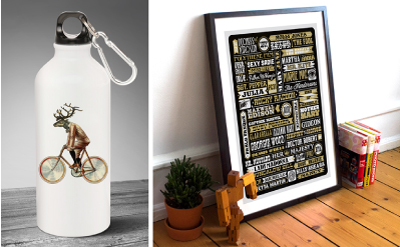
Tell us about who you are and what you do?
Needs & Wishes Art is David and Claudia Slimings. David is a Graphic Designer by profession with experience across many areas including the music industry, packaging, retail, branding and corporate (fun fact: David designed the Peter Andre 2004 release of Mysterious Girl CD jacket). Claudia is the engine room of the business managing the accounts, book keeping and administration (fun fact: Claudia is a trained Epidemiologist!).
Together, we produce designs across a variety of media, including art prints, greeting cards, gifts and homewares, that are influenced by popular culture, music and retro and vintage style (fun fact: David used to run a weekly pop music quiz in his home town of Brighton, UK).
What is graphic design? Tell us about the process?
Graphic design is everywhere. When you see adverts, posters, magazines, websites, and logos, to name a few, they will have involved a graphic designer. Nowadays, graphic design is predominantly computer based using a variety of specialist software programmes such as Photoshop and Illustrator. However, graphic design is not merely being proficient in the use of these programmes or a computer. You still need to have creative, artistic talent.

Yes, very much so. As in our previous point, artistic skill is central to graphic design. Our core set of pop art designs, for example, took approximately 2 months for each design to come to fruition, with constant redrawing, rearranging, adding and subtracting the numerous elements involved to get the finished look. These designs were then carried across a wide range of our products including art prints, drinkware, coasters, throw cushions and clocks. We individually hand-print onto all our drinkware, coasters and clocks in house; we hand-sew the cushions using material that has been custom printed with our designs as well as material that we source (fun fact: Claudia did a cushion making workshop at The Makery and now makes all of Needs & Wishes Arts cushions!) and all of our greetings cards and art prints are designed by ourselves in-house prior to being printed locally by our friendly printer.
What challenges do you experience being graphic designers in the handmade market?
We see no difference in what media is used to present your artistic creations – whether an art print or a mug. In our experience, this is where the understanding of handmade tends to be questioned. Nobody doubts a design produced as an art print or card is handmade (even though they are usually outsourced to a digital printing service), however, place the same design onto other items, especially a ceramic mug, and the “handmade-ness” is met with scepticism, even if, as in our instance, each item is individually hand-printed in house and not outsourced.
The point of difference is in the design, and the design is primarily the handmade element. Unfortunately, people often try to pigeon-hole our work into product categories, rather than the creativity of the design, which we have found a huge barrier when applying for handmade markets, for example.
There are also other challenges to being a handmade business. In addition to making the products, we also have to manage the website, which includes a lot of time getting product images right, visual merchandising for market stalls, marketing and social media campaigns, packing orders, ordering supplies, responding to customer enquiries. There are only two of us, and only one of us is a graphic designer. For example, today’s tasks in addition to writing this blog include designing and ordering a new banner for our market stall, creating images for some new products for our website, organising some new textile printing for our cushion range (and, as usual, chasing up payments).
Do you think our definition of ‘handmade’ hasn’t really caught up with the modern world and new technologies and art forms?
Graphic design is gradually becoming recognised as handmade. The beauty of it is, once a design is created, it can be incorporated onto many products, take the success of Society 6 and Redbubble for example. You can upload your design and have it applied to a range of products that include apparel, bags, lap top covers and even shower curtains and bedding. Handmade has traditionally focused on more physical creations, such as jewellery, pottery, wood work etc. and we feel it is sometimes confused with Artisan (the use of traditional methods) rather than reflecting all that modern day handmade encompasses.
Any myths you want to debunk?
“Handmade in Australia” does not necessarily mean 100% Australian or 100% handmade! Many components that go into a finished product have at some point been manufactured overseas. For example, most paper products such as art prints and greetings cards, will have been printed on stock that has been manufactured overseas. Many jewellery components, candle fragrances, bespoke packaging, textiles and even ingredients used in handmade food products may have been made or sourced from overseas.
But all of this is fine – it is the finished product that would not exist without the creative vision and skill of the maker that is important. This is what we love most about handmade – the diversity of style, techniques and ideas.
What do you see as the future for the handmade sector?
The handmade market is a huge, rapidly growing industry in Australia. There is a drift away from the historical craft “hobbyist” towards people wanting to make a full time career out of doing what they love. The challenge for the handmade market is to nurture and provide a platform for all aspects of art and design while embracing changing technologies and media in the digital era.

We are regularly found at the wonderful Handmade Canberra Market, Kirribilli Art & Design Market, and the Grounds of Alexandria. Our website gives up to date details of the dates, plus you can order our products online! We also sell through Etsy, Hard To Find, and Redbubble and of course, we can be found in-store at WorkShop Makery.